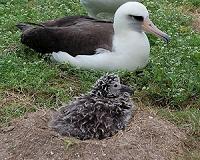 |
Washington DC (SPX) Mar 14, 2011 A new study says chimps, gorillas and other primates grow old gracefully much like humans. The findings come from the first-ever multi-species comparison of primate aging patterns reported in Science. It was long thought that humans, who have relatively long life spans, age more slowly than other animals. But new research funded by the National Science Foundation's Division of Environmental Biology suggests the pace of human aging may not be so unique after all. We had good reason to think human aging was unique, said co-author Anne Bronikowski of Iowa State University. Humans, for example, live longer than many animals with some exceptions--parrots, seabirds, clams and tortoises. But humans are the longest-lived primates. "Humans live for many more years past our reproductive prime," Bronikowski said. "If we were like other mammals, we would start dying fairly rapidly after we reach mid-life. But we don't." Bronikowski is one of 11 biologists and anthropologists whose research figured into the study. "There's been this argument in the scientific literature for a long time that human aging was unique, but we didn't have data on aging in wild primates besides chimps until recently," said another co-author Susan Alberts, a Duke University biologist. The researchers combined data from long-term studies of seven species of wild primates: capuchin monkeys from Costa Rica, muriqui monkeys from Brazil, baboons and blue monkeys from Kenya, chimpanzees from Tanzania, gorillas from Rwanda, and sifaka lemurs from Madagascar. The work focused on the risk of dying. When researchers compared human aging rates--measured as the rate at which mortality risk increases with age--to similar data for nearly 3,000 individual monkeys, apes, and lemurs. The human data fell neatly within the primate continuum. "Human patterns are not strikingly different, even though wild primates experience sources of mortality from which humans may be protected," the authors write in Science. The results also confirm a pattern observed in humans and elsewhere in the animal kingdom: as males age, they die sooner than their female counterparts. In primates, the mortality gap between males and females is narrowest for the species with the least amount of male-male aggression--a monkey called the muriqui--the researchers report. "Muriquis are the only species in our sample in which males do not compete overtly with one another for access to mates," said co-author Karen Strier, an anthropologist at the University of Wisconsin who has studied muriquis since 1982. The results suggest the reason why males of other species die faster than females may be the stress and strain of competition, the authors say. Modern medicine is helping humans live longer than ever before, the researchers note. "Yet we still don't know what governs maximum life span," Alberts said. She is also the associate director of the NSF-funded National Evolutionary Synthesis Center in Durham, N.C. "Some human studies suggest we might be able to live a lot longer than we do now," she said. "Looking to other primates to understand where we are and aren't flexible in our aging will help answer that question." NSF's Directorate for Biological Sciences supports Bronikowski research, along with the research of Alberts, William Morris and Anne Pusey of Duke University. Anthropological Sciences at NSF supports the work of Strier; Jeanne Altmann, Princeton University and Marina Cords, Columbia University, whose primate research also contributed to the study. Three other researchers, Diane Brockman, University of North Carolina-Charlotte; Linda Fedigan, University of Calgary and Tara Stoinski, Dian Fossey Gorilla Fund International and Zoo Atlanta receive funding from other sources. NSF supports all fields of fundamental science and engineering, except for medical sciences, by funding the research of scientists, engineers and educators directly through their own home institutions, typically universities and colleges.
Share This Article With Planet Earth
Related Links Duke University Darwin Today At TerraDaily.com
 Oldest Known Wild Bird In US Returns To Midway To Raise Chick
Oldest Known Wild Bird In US Returns To Midway To Raise ChickMidway Atoll, Pacific (SPX) Mar 11, 2011 The oldest known U.S. wild bird - a coyly conservative 60 - is a new mother. The bird, a Laysan albatross named Wisdom, was spotted a few weeks ago with a chick by John Klavitter, a U.S. Fish and Wildlife Service biologist and the deputy manager of the Midway Atoll National Wildlife Refuge. The bird has sported and worn out 5 bird bands since she was first banded by U.S. Geological Survey ... read more |
|
| The content herein, unless otherwise known to be public domain, are Copyright 1995-2010 - SpaceDaily. AFP and UPI Wire Stories are copyright Agence France-Presse and United Press International. ESA Portal Reports are copyright European Space Agency. All NASA sourced material is public domain. Additional copyrights may apply in whole or part to other bona fide parties. Advertising does not imply endorsement,agreement or approval of any opinions, statements or information provided by SpaceDaily on any Web page published or hosted by SpaceDaily. Privacy Statement |